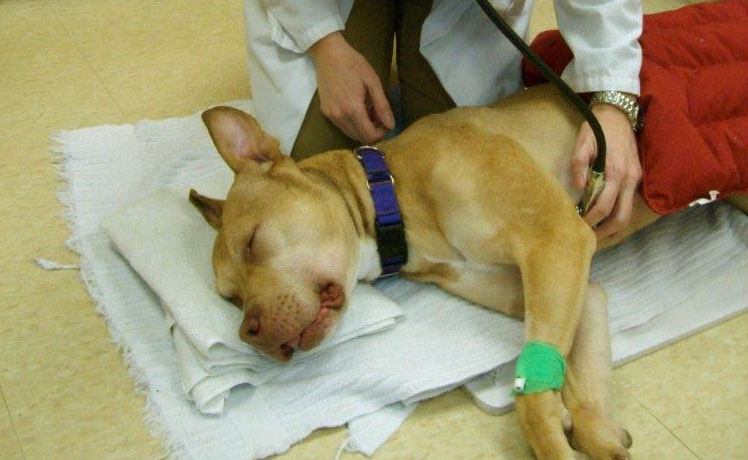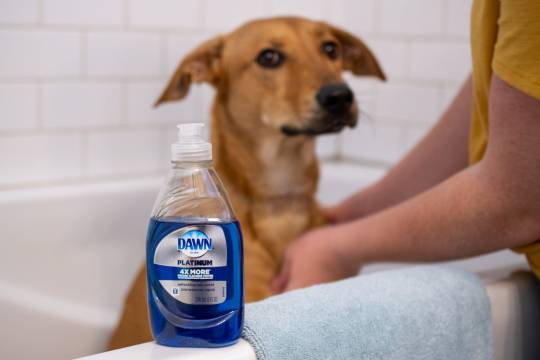Have you noticed some type of bug bites on your dog? Is he itching, biting and scratching? Does he have skin irritation? If so, he could be suffering from flea bites. Flea bites can be very irritating for some dogs, causing them to bite, scratch and simply feel miserable. We’re here with some ideas on how you can take care of your pup’s flea bites, what symptoms to look for and the best flea prevention products for your dog.
Connect with a verified veterinarian in minutes. Licensed vets are available 24/7 to answer your questions. No need to worry about your furry family member.
How Does the Vet Diagnose FAD?
Your vet will do a complete physical exam, and will check your dog for flea bites, skin irritation, etc. They’ll also ask you for a timeline of the symptoms—when did they first appear, how has your dog been acting (itching, etc.). The vet may also run some skin and blood tests to rule out other causes—tests may even include allergy blood tests in order to make a diagnosis.
How to Treat Flea Bites on Dogs
The vet may prescribe certain prescription medications to help relieve the itching and heal the infections he may have developed. Treatment may include antihistamines and a round of corticosteroids (such as prednisone) for the itching and irritation, which will provide dog flea allergy relief. If the skin in infected, your pup may also have to take antibiotics or antifungal medications, depending on what’s causing the infection. In addition, your vet may also prescribe a dewormer, as fleas can carry tapeworms. The tapeworms can develop and live in your dog’s intestines, causing yet another health issue that can be quite serious if left untreated. Your vet may also prescribe medicated shampoos that help to relieve your pup’s itching.
Finally, your vet will want to discuss flea prevention and flea control products with you. If you suspect a flea infestation, then your entire home and yard will need to be treated. Fleas can be difficult to get rid of, but you’ll need to do everything possible to get rid of the little biting varmints.

Review symptoms, medications & behavior to keep your pets healthy with a Vet Online in just minutes.
Ask a Vet Live NowDog Flea Medication
If you haven’t used any form of flea prevention, the vet may also talk with you about treatments you can use to get rid of and prevent fleas on your fur baby. There are different types of treatments available—we’ll take a look at the top 10 flea preventions you can use to get rid of fleas. For flea treatments such as Frontline, etc. be sure to buy the right medication. These medications are generally sold in the dosage determined for your dog’s weight. This is critical—using the wrong medication could be harmful to your pet, or at least not provide enough protection against fleas. If you buy a treatment that’s meant for dogs that are over 100 lbs. and use it on a dog that’s only 20 lbs., your dog would receive too much medication and it could suffer an overdose that leads to death. So be sure to buy the right medication for the size of your dog to avoid these issues.
Please remember that the flea treatments listed in this article are only for dogs (aside from two oral treatments that are included in this article—they’re safe for both dogs and cats). Never give or apply a dog flea prevention medication to your cat. The ingredients in dog flea prevention treatments are made specifically for dogs—not cats. Applying these medications to your cat could cause a toxic reaction leading to death. If your kitty fur baby needs to be treated for fleas, be sure to by her preventive medications made especially for cats. One more note: it’s a good idea to always wash your hands after applying any type of insecticidal flea treatment to your fur baby. You want to avoid accidentally getting the insecticide in your mouth or eyes, etc.
Best Topical Flea Treatments for Dogs
1. Frontline Plus
This is a flea & tick prevention medication you give your dog once a month. It’s waterproof, fast-acting and provides month-long control for both fleas and ticks. This medication breaks the flea’s life cycle, meaning it will kill adult fleas, their eggs and larvae. This treatment will kill ticks, including those that transmit tick diseases such as Lyme disease. Frontline is easy to apply—just open the applicator and snap the applicator tip, then apply to your pup’s hair between the shoulder blades and you might also include a spot near the base of his tail. You must be sure to use up the entire applicator of medication to be sure your fur baby will be completely protected for the entire 30 days.
2. PetArmour Flea & Tick Treatment for Dogs
This medication works to kill adult fleas, lice and ticks and works in as little as an hour after application. The treatment lasts for 30 days. The active ingredient in this flea treatment is fipronil. This flea and tick treatment’s also easy to use. Just remove one tube from the package, then hold the tub with the notched end pointing up and away from the face and body. Use scissors to cut off the narrow end at the notch—along the line provided. Turn the tube over your dog and part your pup’s fur in between his shoulder blades. Just firmly squeeze the tube to apply the entire contents to your pup’s skin. And that’s it! Apply one tube per month to continuously protect against fleas, lice and ticks.
3. Bayer K9 Advantix II
The advertising for this flea & tick prevention says “No biting required!” Not only does this product kill fleas and ticks, but it also works to kill mosquitoes and lice, while repelling biting flies! K9 Avantix II works in as little as ten minutes after applying. This treatment is applied once a month and kills these pests on contact. The active ingredients include imidacloprid, permethrin, pyripoxyfen.
4. Sentry Fiproguard for Dogs
This is another recommended flea prevention topical medication for dogs. Sentry Fiproguard for Dogs kills fleas, ticks, and biting lice for up to 30 days. It’s waterproof and comes in an easy-to-use application tube. The medication should be applied to the skin between your dog’s shoulder blades.
Oral Flea Treatments for Dogs
Another option to consider are oral flea treatments for dogs. You might choose this option if your dog will not sit still for a topical application or just doesn’t like it.
5. Capstar Flea Tablets for Dogs & Cats
This is an oral treatment for both dogs and cats that you give once a month. The fast-acting formula will begin working with 30 minutes and is guaranteed to kill almost all adult fleas within four hours of your pet taking the medication. This flea prevention is also safe for puppies and kittens over the age of 4 weeks and even for pregnant and nursing dogs and cats.
6. PetArmour FastCaps for Dogs & Cats
This product contains nitenpyram, which is an oral flea medication that works to kill fleas fast. The easy-to-take tablets work in as little as 30 minutes and offer protection that won’t rub or wash off. It’s safe for both cats and dogs!
7. Bayer Advantus Soft Chews
This is another fast-working flea treatment for dogs. A single dose will start to kill fleas within an hour. The treatment can safely be used once a day, as needed. This treatment is also safe for puppies over the age of 10 weeks and older, that weigh at least 4 pounds or more. This medication is given by weight—be sure to read all directions on the bottle for dose instructions.
Dog Flea Collars
Flea collars are another popular option to prevent fleas. They work by releasing chemicals that are absorbed by the dog’s skin. They can be effective at protecting against fleas and ticks from living on your fur baby. However, they aren’t the best option if you’re dealing with a flea infestation. In that instance, you’ll need to use either a topical or oral flea treatment.
8. Bayer Seresto Flea and Tick Collar
This product is made by Bayer and works as a flea and tick prevention for dogs. You won’t have to deal with messy topical applications or tablets your dog may not like. It kills fleas and ticks on contact. One flea collar works to protect your dog continuously for 8 months.
9. Cosyworld Flea & Tick Collar
This is another choice if you and your fur baby don’t want to deal with topical applications or flea tablets. Cosyworld Flea & Tick Collar is made with essential oil extracts that are absorbed into your dog’s skin. It works to break the lifecycle of fleas and ticks, without harming your fur baby. These collars work continuously for 8 months, and are safe & eco-friendly—these natural essential oils will not harm your dog. The collar is also water-resistant!
10. Torrix Flea and Tick Collar
This is another flea & tick collar made with natural ingredients that include eucalyptus and citronella oil—which work to repel ticks & fleas. Both of these ingredients are safe for your furry canine companion. The collars are 25 inches long, so are adjustable to fit most dogs—large and small. The collar offers 8 continuous months of flea and tick protection. The Torrix collar is also waterproof and comes with a 60-day money back guarantee if you and your pup aren’t happy with the collar!
We hope this guide has given you a better understanding of dog flea allergies and what you can do to prevent flea infestations and treat your dog at the same time. The guide has also covered several different options to treat fleas on your fur baby—we hope one of these products will work like a charm for your dog. We’d like to wish you and your precious pet many flea and tick-free months to come!
Where Do Fleas Come From?
You and your pets may encounter fleas on walks in the neighborhood, at the dog park and even in your own yard. They’re everywhere! When you and your fur baby enter the house, it’s possible you could both be carrying these little biting monsters inside with you. Not a pleasant thought at all. Not only that, but fleas can live in the house because there’s lots of food in there—you, your family and pets. So, prevention is the best option to keep your home free of fleas. Flea prevention includes flea collars, flea prevention topical treatments or oral treatments against flea infestations.
Other preventive actions you can take include vacuuming your home on a regular basis. You’ll also need to wash all bedding (including your pet’s) in very hot water and dry the bedding on high in the dryer about once a week (until fleas are exterminated). If the infestation is bad enough, you may need to either consider using a “bug” bomb (indoor fogger spray with insecticide) or calling a pest control company to rid your home of fleas. You can also have your yard treated for fleas by using insecticide pellets, sprays, etc. Look for products that contain insect growth regulators, as this will cut the flea’s lifecycle, making it more difficult for them to reproduce.
Dog Flea Bites
So, you’ve found bites on your dog—how can you tell if they’re flea bites or not? You’ll have to do a visual check of your fur baby’s skin to see if he has bug bites. It’s not an easy job, especially if your pup has long fur or a double layered fur coat. You’ll have to get down to his skin to see if you find evidence of flea bites. Flea bites on dogs look like small, raised red areas. Your pet may be itching and scratching these areas—this can cause inflammation; however, the bites will not enlarge like mosquito bites. The bites will remain the same size. To make sure these bites are caused by fleas, you may want to use a flea comb through your pet’s fur to catch the little biting varmints—just to make sure it’s fleas you’re dealing with.
Dog Flea Allergy Dermatitis
Some dogs, just like their humans, can have an allergic reaction to bug bites, including flea bites. Your poor fur baby may exhibit these signs if he’s having an allergic reaction to the bites:
- Hair loss (especially on the back and near the tail)
- Red, raised irritated skin
- Intense itching and scratching (if will be as if your dog just can’t stop)
- Chewing and/or biting at certain areas
- Blisters on the skin
Your furry canine companion could also develop something called flea allergy dermatitis (FAD). This condition is quite common in dogs with allergies, and can include extreme itching, biting and scratching. When fleas bite, their saliva is released into the skin and the proteins in the saliva cause the skin reaction in dogs who are allergic to flea bites. Dogs with FAD may not even be infested with fleas—it only takes a few bites to set off the allergic reaction. In addition to the allergic reaction, your pet could also develop a skin bacterial or yeast infection, as biting and scratching can further damage the skin. The damaged skin then can allow these secondary medical problems to develop, which also makes the skin itch even more.
Connect with a verified veterinarian in minutes. Licensed vets are available 24/7 to answer your questions. No need to worry about your furry family member.

Kyoko
Kyoko is from a family of 3 and moved to New York with her parents and siblings when she was 13. Kyoko is fond of spending a great amount of time with pets, specifically her beagle Luna and cat Missy. Her boyfriend often complains that she spends too much time giving attention to their animals. Kyoko has written dozens of articles concerning pets and is aiming at owning a pet shop one day!
Review symptoms, medications & behavior to keep your pets healthy with a Vet Online in just minutes.
Ask a Vet Live Now



